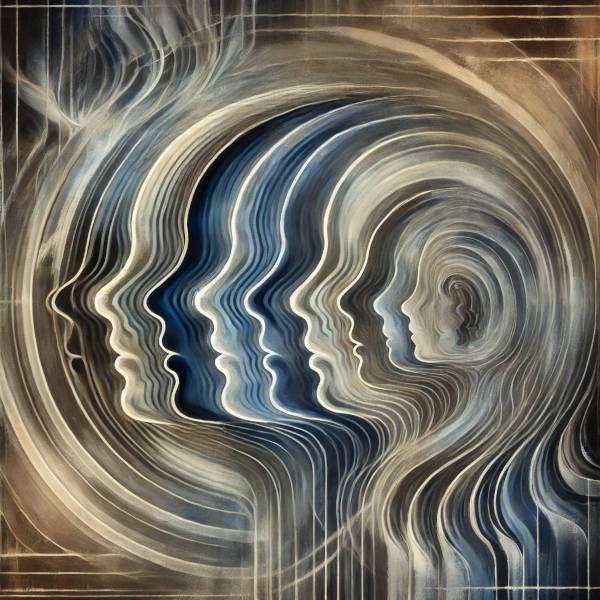Understanding Recursion
Recursion is a concept in computer science and mathematics where a function or process calls or refers to itself in order to solve a problem. This self-referencing behavior allows complex problems to be broken down into simpler, more manageable sub-problems. The process continues until a base case or stopping condition is met, which prevents infinite repetition.
The concept of recursion is fundamental to fractals, geometric shapes that exhibit self-similarity, meaning they look similar at different levels of magnification. This self-similarity is often generated through recursive processes, where the same pattern is repeated at progressively smaller scales. This can produce an intricate design that maintains its complexity regardless of how much it is zoomed in or out.
The Sierpinski Triangle is a classic example of a fractal generated using recursion:
- Start with an equilateral triangle.
- Divide it into four smaller triangles by drawing lines connecting the midpoints of each side.
- Remove the central triangle, leaving three smaller triangles around it.
- Repeat the process with each of the remaining smaller triangles.
- Continue recursively subdividing and removing the central triangle from each new set of triangles.
The fractal universe is the idea that the structure of the universe may exhibit patterns of self-similarity across different scales, similar to how fractals work in mathematics. In this concept, the large-scale structure of the universe (galaxies, clusters of galaxies, and voids) might repeat itself in similar patterns at smaller or larger scales, potentially suggesting that the universe is structured like a fractal.
- Self-Similarity: Just like a fractal, where smaller parts resemble the whole, the universe could exhibit similar patterns at multiple levels, from subatomic particles to galaxies.
- Scale-Invariance: No matter how much you "zoom in" or "zoom out," the pattern of the universe’s structure might look the same or follow similar rules.
- Complexity at All Levels: Just as fractals show infinite complexity, the fractal universe concept suggests that the cosmos might be infinitely complex at all scales, with repeating structures.
While this idea is a fascinating concept, it's debated in cosmology. Observations show that up to a certain scale, the universe is homogeneous (uniform), but some patterns, like the distribution of galaxies, exhibit fractal-like clustering.
Recursion, fractals and physical reality
Fractals are not just mathematical constructs; they are also abundant in nature. Many natural structures exhibit self-similarity and complexity at different scales, much like fractals. This makes fractals a useful concept for understanding and describing these patterns in nature.
Examples:
-
Coastlines: The shape of a coastline is a classic example of a fractal pattern. No matter how closely you zoom in on a coastline, it continues to show complex, jagged patterns, making it difficult to measure its length precisely.
-
Mountains and River Networks: Mountain ranges and river networks exhibit fractal geometry. Rivers branch into smaller streams, which in turn branch into even smaller rivulets, mimicking the self-similarity seen in fractals.
-
Trees and Plants: The branching patterns of trees, roots, and leaves often resemble fractals. Each branch of a tree is like a smaller version of the whole tree, with branches repeatedly dividing into smaller branches.
-
Snowflakes: Snowflakes exhibit fractal-like patterns. Each arm of a snowflake develops similarly, creating a complex but self-similar structure.
-
Clouds: The formation of clouds follows fractal geometry. The fluffy, irregular edges of clouds look similar at different scales, showing fractal behavior.
-
Ferns: Fern leaves are a well-known example of natural fractals. Each frond is made up of smaller leaves that resemble the entire frond.
-
Lightning: Lightning bolts follow fractal-like paths. The main bolt branches into smaller offshoots, and these branches continue splitting, creating a self-similar, jagged pattern.
-
Blood Vessels and Lungs: The human circulatory system and the structure of lungs exhibit fractal properties. Blood vessels and airways branch out into smaller and smaller tubes, ensuring efficient transport of blood and air.
Why Do Fractals Appear in Nature:
Fractal patterns often emerge in natural systems because they are efficient and optimize space, energy, or resource distribution. For example, tree branches maximize exposure to sunlight, and river networks efficiently drain a landscape.
Fractals in technology
Fractals have several important applications in technology due to their unique properties of self-similarity, efficiency, and complexity. These properties make fractals ideal for a range of applications, especially in fields that require intricate patterns, efficient designs, or compressed data. Here are some key areas where fractals are used in technology:
1. Computer Graphics and Animation:
Fractals are widely used in computer graphics to create realistic natural environments such as:
- Landscapes: Mountains, clouds, and coastlines are generated using fractal algorithms (e.g., fractal terrain generation). The repeating self-similarity of fractals creates convincing textures that resemble real-world landscapes.
- Plants and Trees: Fractal-based algorithms are used to model the branching patterns of trees, bushes, and other plants.
- Special Effects: Fractal noise is used in animation and special effects to simulate textures, fire, and other natural phenomena.
2. Image Compression:
Fractal image compression is a technique that uses self-similar patterns within images to compress data efficiently. Since many images contain repeating patterns, fractal algorithms can use these recurrences to represent the image more compactly.
- Fractal Compression: Instead of storing the entire image pixel by pixel, fractal compression stores rules for recreating the image by repeatedly applying fractal transformations, significantly reducing the file size.
3. Antenna Design:
Fractal antennas are small, efficient antennas that use fractal shapes to improve signal reception and transmission across a wide range of frequencies.
- Wideband and Multiband Antennas: The self-similar structure of fractal antennas allows them to operate on multiple frequencies, making them ideal for devices that need to communicate over a range of signals (e.g., mobile phones, GPS devices).
- Compact Design: Fractal antennas can be smaller than traditional antennas, making them useful in devices with space constraints.
4. Network Design and Analysis:
Fractal models are used to study and optimize complex networks such as the Internet, power grids, and communication networks.
- Self-Similarity in Networks: Some networks, like the Internet, display fractal-like properties in their topology. Understanding these properties helps in designing more efficient and robust networks.
- Fractal Traffic Patterns: Network traffic can exhibit fractal behavior, where patterns repeat across different time scales. Understanding this helps in managing congestion and optimizing data flow.
5. Signal and Data Processing:
Fractals are used in signal processing for analyzing and compressing complex data, including audio, video, and other forms of communication signals.
- Fractal Filtering: Fractals can help filter out noise or unwanted signals in telecommunications and data transmission by identifying self-similar patterns.
- Wavelet Transforms: A type of fractal transformation, wavelets are used in data compression, denoising, and image processing to break down signals into manageable parts.
6. Medical Imaging:
Fractal analysis is applied in medical imaging to identify patterns in biological structures and detect abnormalities.
- Fractal Tumor Analysis: Tumors often exhibit fractal-like growth patterns, so fractal analysis can help in diagnosing and predicting the development of cancer.
- Fractal-based MRI Analysis: Fractals are used in the analysis of brain scans and other MRI data to detect structural irregularities.
7. Fractal Robots:
Fractal robots, also known as modular self-reconfiguring robots, are designed using fractal principles. These robots can change their shape and adapt to different tasks by assembling and disassembling smaller, self-similar modules.
- Adaptive Structures: Fractal robots are useful in environments where adaptability is key, such as space exploration or search-and-rescue missions.
8. 3D Printing:
Fractal structures are used in 3D printing to create complex, lightweight, and strong objects. The self-similar patterns allow for optimal material usage, making objects both durable and efficient in weight.
- Fractal Lattices: 3D printed objects can use fractal lattices for strength while minimizing material consumption, useful in industries like aerospace and automotive engineering.
9. Cryptography:
Fractals play a role in some advanced cryptographic algorithms. The complexity and unpredictability of fractals make them suitable for encryption, where secure and efficient key generation is crucial.
- Fractal-based Encryption: Algorithms based on fractals can generate highly complex keys that are difficult to break due to their recursive nature.
10. Music and Sound Synthesis:
Fractals are used in music composition and sound synthesis, particularly in generating complex, evolving patterns in audio.
- Fractal Music Generation: Algorithms generate music based on fractal patterns, leading to compositions that have repetitive but unpredictable elements, similar to how fractals behave.
- Sound Wave Patterns: In sound synthesis, fractal algorithms are used to create textures and natural soundscapes.
Recursion, fractals and physical reality
Some interpretations of quantum mechanics involve recursive or self-similar structures. For instance, fractals have been found in the patterns of certain quantum systems, like electron clouds and the distribution of energy levels in atoms.
While debated, the concept of a fractal universe suggests that galaxies, clusters, and cosmic voids might follow recursive, self-similar patterns, hinting at deep connections between recursion and the large-scale structure of reality.
In complex systems theory, recursion is key to self-organization. Many natural systems, like ecosystems or social networks, organize themselves through recursive processes. Feedback loops in these systems give rise to emergent properties - complex behaviors that arise from simple rules. For example, the collective movement of flocks of birds or the formation of galaxies might emerge from recursive, self-organizing principles.
While recursion can model many aspects of reality, there are practical limits:
- Computational Power: Recursive algorithms can be computationally expensive, especially if they do not converge quickly. Infinite recursion can also lead to stack overflow in programming, just as physical systems must obey energy limits.
- Physical Boundaries: In nature, recursive processes (like fractal growth) eventually reach physical limitations. For example, a tree’s branching pattern can’t continue infinitely—it is limited by factors like nutrient availability and gravity.
Fractals are closely tied to chaos theory, which deals with systems that appear random but are governed by deterministic rules:
- Strange Attractors: These are fractal-like structures that arise in chaotic systems, showing how even seemingly chaotic processes can have an underlying recursive order. For example, weather patterns might be chaotic but have fractal dimensions.
- Sensitivity to Initial Conditions: In recursive systems, a small change in the initial input can lead to vastly different outcomes, a concept central to chaos theory and observed in many real-world systems (e.g., the "butterfly effect").

